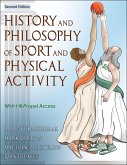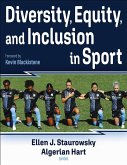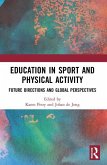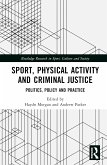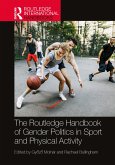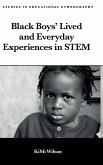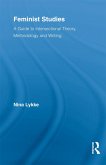Sociocultural Issues in Sport and Physical Activity
Herausgeber: Andrews, David L.; Pitter, Robert; Newman, Joshua I.
Sociocultural Issues in Sport and Physical Activity
Herausgeber: Andrews, David L.; Pitter, Robert; Newman, Joshua I.
- Broschiertes Buch
- Merkliste
- Auf die Merkliste
- Bewerten Bewerten
- Teilen
- Produkt teilen
- Produkterinnerung
- Produkterinnerung
Sociocultural Issues in Sport and Physical Activity explores the intersections between modern physical activity and society. The text applies social theory to a broad range of physical activities such as sports, fitness, dance, weightlifting, and others.
Andere Kunden interessierten sich auch für
![History and Philosophy of Sport and Physical Activity History and Philosophy of Sport and Physical Activity]() R. Scott KretchmarHistory and Philosophy of Sport and Physical Activity136,99 €
R. Scott KretchmarHistory and Philosophy of Sport and Physical Activity136,99 €![Diversity, Equity, and Inclusion in Sport Diversity, Equity, and Inclusion in Sport]() Diversity, Equity, and Inclusion in Sport100,99 €
Diversity, Equity, and Inclusion in Sport100,99 €![Education in Sport and Physical Activity Education in Sport and Physical Activity]() Education in Sport and Physical Activity37,99 €
Education in Sport and Physical Activity37,99 €![Sport, Physical Activity and Criminal Justice Sport, Physical Activity and Criminal Justice]() Sport, Physical Activity and Criminal Justice165,99 €
Sport, Physical Activity and Criminal Justice165,99 €![The Routledge Handbook of Gender Politics in Sport and Physical Activity The Routledge Handbook of Gender Politics in Sport and Physical Activity]() The Routledge Handbook of Gender Politics in Sport and Physical Activity199,99 €
The Routledge Handbook of Gender Politics in Sport and Physical Activity199,99 €![Black Boys' Lived and Everyday Experiences in STEM Black Boys' Lived and Everyday Experiences in STEM]() KiMi Wilson (USA California State University)Black Boys' Lived and Everyday Experiences in STEM77,99 €
KiMi Wilson (USA California State University)Black Boys' Lived and Everyday Experiences in STEM77,99 €![Feminist Studies Feminist Studies]() Nina Lykke (Sweden Linkoping University)Feminist Studies74,99 €
Nina Lykke (Sweden Linkoping University)Feminist Studies74,99 €-
-
-
Sociocultural Issues in Sport and Physical Activity explores the intersections between modern physical activity and society. The text applies social theory to a broad range of physical activities such as sports, fitness, dance, weightlifting, and others.
Hinweis: Dieser Artikel kann nur an eine deutsche Lieferadresse ausgeliefert werden.
Hinweis: Dieser Artikel kann nur an eine deutsche Lieferadresse ausgeliefert werden.
Produktdetails
- Produktdetails
- Verlag: Human Kinetics Publishers
- Seitenzahl: 320
- Erscheinungstermin: 18. Mai 2022
- Englisch
- Abmessung: 216mm x 279mm x 15mm
- Gewicht: 932g
- ISBN-13: 9781450468657
- ISBN-10: 1450468659
- Artikelnr.: 62081624
- Herstellerkennzeichnung
- Libri GmbH
- Europaallee 1
- 36244 Bad Hersfeld
- 06621 890
- Verlag: Human Kinetics Publishers
- Seitenzahl: 320
- Erscheinungstermin: 18. Mai 2022
- Englisch
- Abmessung: 216mm x 279mm x 15mm
- Gewicht: 932g
- ISBN-13: 9781450468657
- ISBN-10: 1450468659
- Artikelnr.: 62081624
- Herstellerkennzeichnung
- Libri GmbH
- Europaallee 1
- 36244 Bad Hersfeld
- 06621 890
Robert Pitter, PhD, is a professor at Acadia University. His publications have examined sport, physical activity, and society as well as environmental education and organizational theory. He has been published in such journals as Research in Sport and Exercise Quarterly, Quest, Sociology of Sport Journal, International Review for Sociology of Sport, and Journal of Sport and Social Issues. David L. Andrews is a professor of physical cultural studies in the department of kinesiology at the University of Maryland. He is also an affiliate faculty member in the department of American studies and the department of sociology. Dr. Andrews' research interests center on contextualizing sport and physical culture in relation to the intersecting cultural, political, economic, and technological forces shaping contemporary society. His latest book is titled Making Sport Great Again? The Uber-Sport Assemblage, Neoliberalism, and the Trump Conjuncture (published by Palgrave). Previous books include Sport-Commerce-Culture: Essays on Sport in Late Capitalist America (published by Peter Lang), Sport and Neoliberalism: Politics, Consumption, and Culture (edited with Michael Silk and published by Temple University Press), The Routledge Handbook of Physical Cultural Studies (edited with Michael Silk and Holly Thorpe and published by Routledge), and Sport, Physical Culture, and the Moving Body: Materialisms, Technologies, Ecologies (edited with Joshua Newman and Holly Thorpe and published by Rutgers University Press). His current book project is titled The Great Moving Right Show: Sport, Political Assemblages, and the Trump Awakening (to be published by Rutgers University Press). Joshua I. Newman, PhD, is director of the Center for Sport, Health, and Equitable Development and a professor of sport, media, and cultural studies at Florida State University. He is also the doctorate program coordinator and associate chair in the department of sport management. Previously, Newman was a lecturer of sport studies at the University of Otago in New Zealand. In 2017, he served as president and research fellow of the North American Society for the Sociology of Sport (NASSS). He currently serves on the editorial boards of Communication & Sport, International Review for the Sociology of Sport, and Sociology of Sport Journal. Newman’s work has featured in The Society Pages, the Somatic Podcast, and the Global Sport Matters Podcast, and he has done interviews for the Washington Post, Time magazine, BuzzFeed, and the Associated Press.
Part I. Body Institutions: Foundations and Considerations
Chapter 1. Introduction
Robert Pitter, David L. Andrews, and Brandon Wallace
Defining Physical Culture
Physical Culture and the Sociological Imagination
The Importance of a Critical and Theoretical Approach
Case Study: Fitness and Society
Conclusion
Chapter 2. Politics of the Active Body
Andrew Grainger, Brandon Wallace, and David L. Andrews
Politics as Power
Antonio Gramsci and Hegemony
Hegemony, Sport, and the Active Body
Dominant, Residual, and Emergent Forms of Physical Culture
Conclusion
Chapter 3. Critical Pedagogy and the Active Body
Ryan King-White and Matthew Hawzen
The Focus of Physical Education
Critical Pedagogy
Understanding and Applying Critical Pedagogy
Critical Pedagogy in Kinesiology
Conclusion
Chapter 4. Medicine, Technology, and the Active Body
Katelyn Esmonde
Physical Activity and Epidemiology
Physical Technocultures
Sociocultural Issues and Possibilities for Technologies of Physical Culture
Conclusion
Chapter 5. The Corporeal Sport Economy
Adam Beissel, Chris McLeod, and David L. Andrews
The Economic Base and Sporting Superstructure
Sport and Capitalism
The Late Capitalist (Cultural) Economy
Sport and Late Capitalism
What Is a Corporeal Economy?
The Material and Social Relations of Late Capitalist Production
The Active Body as Instrument in Sport Production
The Active Body as Object of Sport Production
Conclusion
Part II. Body Stratification: Meanings and Social Identities
Chapter 6. Gender, Sex, and Physical Culture
Shannon Jette, David L. Andrews, and Robert Pitter
Social Construction of Gendered Identities
Performances of Exercise Culture
Performances of Sport Culture
Expanding the Range of Gender Identity Through Physical Culture
Conclusion
Chapter 7. Racialized Bodies and Black and Indigenous Physical Cultures
Brandon Wallace, Robert Pitter, and David L. Andrews
Disrupting the Myth of Race
Race or Ethnicity?
African Americans and Black Physical Culture
Native Americans and Indigenous Physical Cultures
Conclusion
Chapter 8. Social Class, Habitus, and Physical Culture
Robert Pitter, David L. Andrews, and Brandon Wallace
How Social Class Matters
Social Class Distribution of Physical Activity
Class Habitus, Hexis, and Embodied Lifestyle Cultures
Conclusion
Chapter 9. Disability, Sport, Activity, and Public Health
Mollie Greenberg and Stephanie J. Cork
What Is Disability? A Note on Language
Early History of Disability in Society
Current Models of Disability
Activism and Civil Rights Legislation
Confronting Health, Illness and Disability
Discrimination Against People With Disabilities
Adapted Physical Activity and Sport
Neurodiversity
The Special Olympics
Conclusion
Part III. Body Movements: Scales and Spaces
Chapter 10. Popular Culture and the Active Body
Michael D. Giardina and A. Lamont Williams
A Note About Popular Culture
The Active Body in Early Popular Culture
The Active Body in Contemporary Popular Culture
Conclusion
Chapter 11. Physical Activity and Community
Robert Pitter, Brandon Wallace, and David L. Andrews
Conceptualizing Community
Creating Community via Physical Culture
Community Development via Physical Activity
Conclusion
Chapter 12. The Active Body in Cities
Oliver J.C. Rick, Jacob J. Bustad, and Bryan C. Clift
The Rise of the Neoliberal City
Models of Urban Physical Activity Provision
Creative Sport and Recreation: Designing Physical Activity Attractions
Conclusion
Chapter 13. Globalization and Physical Activity
Joshua Newman, David L. Andrews, and Robert Pitter
Local and Global Movements
What Is Globalization?
Debates on Globalization
Global Physical Culture
Global Media Spectacles
The Globalization of Culture and Economy
Economic Globalization at Work
The Problem of Global Sporting Goods Production
Global Migration: People on the Move
Conclusion
Chapter 14. The Environment and the Active Body
Martin Barrett and Kyle S. Bunds
The Body as the Environment
The Body in the Environment
The Body for the Environment
Conclusion
Chapter 1. Introduction
Robert Pitter, David L. Andrews, and Brandon Wallace
Defining Physical Culture
Physical Culture and the Sociological Imagination
The Importance of a Critical and Theoretical Approach
Case Study: Fitness and Society
Conclusion
Chapter 2. Politics of the Active Body
Andrew Grainger, Brandon Wallace, and David L. Andrews
Politics as Power
Antonio Gramsci and Hegemony
Hegemony, Sport, and the Active Body
Dominant, Residual, and Emergent Forms of Physical Culture
Conclusion
Chapter 3. Critical Pedagogy and the Active Body
Ryan King-White and Matthew Hawzen
The Focus of Physical Education
Critical Pedagogy
Understanding and Applying Critical Pedagogy
Critical Pedagogy in Kinesiology
Conclusion
Chapter 4. Medicine, Technology, and the Active Body
Katelyn Esmonde
Physical Activity and Epidemiology
Physical Technocultures
Sociocultural Issues and Possibilities for Technologies of Physical Culture
Conclusion
Chapter 5. The Corporeal Sport Economy
Adam Beissel, Chris McLeod, and David L. Andrews
The Economic Base and Sporting Superstructure
Sport and Capitalism
The Late Capitalist (Cultural) Economy
Sport and Late Capitalism
What Is a Corporeal Economy?
The Material and Social Relations of Late Capitalist Production
The Active Body as Instrument in Sport Production
The Active Body as Object of Sport Production
Conclusion
Part II. Body Stratification: Meanings and Social Identities
Chapter 6. Gender, Sex, and Physical Culture
Shannon Jette, David L. Andrews, and Robert Pitter
Social Construction of Gendered Identities
Performances of Exercise Culture
Performances of Sport Culture
Expanding the Range of Gender Identity Through Physical Culture
Conclusion
Chapter 7. Racialized Bodies and Black and Indigenous Physical Cultures
Brandon Wallace, Robert Pitter, and David L. Andrews
Disrupting the Myth of Race
Race or Ethnicity?
African Americans and Black Physical Culture
Native Americans and Indigenous Physical Cultures
Conclusion
Chapter 8. Social Class, Habitus, and Physical Culture
Robert Pitter, David L. Andrews, and Brandon Wallace
How Social Class Matters
Social Class Distribution of Physical Activity
Class Habitus, Hexis, and Embodied Lifestyle Cultures
Conclusion
Chapter 9. Disability, Sport, Activity, and Public Health
Mollie Greenberg and Stephanie J. Cork
What Is Disability? A Note on Language
Early History of Disability in Society
Current Models of Disability
Activism and Civil Rights Legislation
Confronting Health, Illness and Disability
Discrimination Against People With Disabilities
Adapted Physical Activity and Sport
Neurodiversity
The Special Olympics
Conclusion
Part III. Body Movements: Scales and Spaces
Chapter 10. Popular Culture and the Active Body
Michael D. Giardina and A. Lamont Williams
A Note About Popular Culture
The Active Body in Early Popular Culture
The Active Body in Contemporary Popular Culture
Conclusion
Chapter 11. Physical Activity and Community
Robert Pitter, Brandon Wallace, and David L. Andrews
Conceptualizing Community
Creating Community via Physical Culture
Community Development via Physical Activity
Conclusion
Chapter 12. The Active Body in Cities
Oliver J.C. Rick, Jacob J. Bustad, and Bryan C. Clift
The Rise of the Neoliberal City
Models of Urban Physical Activity Provision
Creative Sport and Recreation: Designing Physical Activity Attractions
Conclusion
Chapter 13. Globalization and Physical Activity
Joshua Newman, David L. Andrews, and Robert Pitter
Local and Global Movements
What Is Globalization?
Debates on Globalization
Global Physical Culture
Global Media Spectacles
The Globalization of Culture and Economy
Economic Globalization at Work
The Problem of Global Sporting Goods Production
Global Migration: People on the Move
Conclusion
Chapter 14. The Environment and the Active Body
Martin Barrett and Kyle S. Bunds
The Body as the Environment
The Body in the Environment
The Body for the Environment
Conclusion
Part I. Body Institutions: Foundations and Considerations
Chapter 1. Introduction
Robert Pitter, David L. Andrews, and Brandon Wallace
Defining Physical Culture
Physical Culture and the Sociological Imagination
The Importance of a Critical and Theoretical Approach
Case Study: Fitness and Society
Conclusion
Chapter 2. Politics of the Active Body
Andrew Grainger, Brandon Wallace, and David L. Andrews
Politics as Power
Antonio Gramsci and Hegemony
Hegemony, Sport, and the Active Body
Dominant, Residual, and Emergent Forms of Physical Culture
Conclusion
Chapter 3. Critical Pedagogy and the Active Body
Ryan King-White and Matthew Hawzen
The Focus of Physical Education
Critical Pedagogy
Understanding and Applying Critical Pedagogy
Critical Pedagogy in Kinesiology
Conclusion
Chapter 4. Medicine, Technology, and the Active Body
Katelyn Esmonde
Physical Activity and Epidemiology
Physical Technocultures
Sociocultural Issues and Possibilities for Technologies of Physical Culture
Conclusion
Chapter 5. The Corporeal Sport Economy
Adam Beissel, Chris McLeod, and David L. Andrews
The Economic Base and Sporting Superstructure
Sport and Capitalism
The Late Capitalist (Cultural) Economy
Sport and Late Capitalism
What Is a Corporeal Economy?
The Material and Social Relations of Late Capitalist Production
The Active Body as Instrument in Sport Production
The Active Body as Object of Sport Production
Conclusion
Part II. Body Stratification: Meanings and Social Identities
Chapter 6. Gender, Sex, and Physical Culture
Shannon Jette, David L. Andrews, and Robert Pitter
Social Construction of Gendered Identities
Performances of Exercise Culture
Performances of Sport Culture
Expanding the Range of Gender Identity Through Physical Culture
Conclusion
Chapter 7. Racialized Bodies and Black and Indigenous Physical Cultures
Brandon Wallace, Robert Pitter, and David L. Andrews
Disrupting the Myth of Race
Race or Ethnicity?
African Americans and Black Physical Culture
Native Americans and Indigenous Physical Cultures
Conclusion
Chapter 8. Social Class, Habitus, and Physical Culture
Robert Pitter, David L. Andrews, and Brandon Wallace
How Social Class Matters
Social Class Distribution of Physical Activity
Class Habitus, Hexis, and Embodied Lifestyle Cultures
Conclusion
Chapter 9. Disability, Sport, Activity, and Public Health
Mollie Greenberg and Stephanie J. Cork
What Is Disability? A Note on Language
Early History of Disability in Society
Current Models of Disability
Activism and Civil Rights Legislation
Confronting Health, Illness and Disability
Discrimination Against People With Disabilities
Adapted Physical Activity and Sport
Neurodiversity
The Special Olympics
Conclusion
Part III. Body Movements: Scales and Spaces
Chapter 10. Popular Culture and the Active Body
Michael D. Giardina and A. Lamont Williams
A Note About Popular Culture
The Active Body in Early Popular Culture
The Active Body in Contemporary Popular Culture
Conclusion
Chapter 11. Physical Activity and Community
Robert Pitter, Brandon Wallace, and David L. Andrews
Conceptualizing Community
Creating Community via Physical Culture
Community Development via Physical Activity
Conclusion
Chapter 12. The Active Body in Cities
Oliver J.C. Rick, Jacob J. Bustad, and Bryan C. Clift
The Rise of the Neoliberal City
Models of Urban Physical Activity Provision
Creative Sport and Recreation: Designing Physical Activity Attractions
Conclusion
Chapter 13. Globalization and Physical Activity
Joshua Newman, David L. Andrews, and Robert Pitter
Local and Global Movements
What Is Globalization?
Debates on Globalization
Global Physical Culture
Global Media Spectacles
The Globalization of Culture and Economy
Economic Globalization at Work
The Problem of Global Sporting Goods Production
Global Migration: People on the Move
Conclusion
Chapter 14. The Environment and the Active Body
Martin Barrett and Kyle S. Bunds
The Body as the Environment
The Body in the Environment
The Body for the Environment
Conclusion
Chapter 1. Introduction
Robert Pitter, David L. Andrews, and Brandon Wallace
Defining Physical Culture
Physical Culture and the Sociological Imagination
The Importance of a Critical and Theoretical Approach
Case Study: Fitness and Society
Conclusion
Chapter 2. Politics of the Active Body
Andrew Grainger, Brandon Wallace, and David L. Andrews
Politics as Power
Antonio Gramsci and Hegemony
Hegemony, Sport, and the Active Body
Dominant, Residual, and Emergent Forms of Physical Culture
Conclusion
Chapter 3. Critical Pedagogy and the Active Body
Ryan King-White and Matthew Hawzen
The Focus of Physical Education
Critical Pedagogy
Understanding and Applying Critical Pedagogy
Critical Pedagogy in Kinesiology
Conclusion
Chapter 4. Medicine, Technology, and the Active Body
Katelyn Esmonde
Physical Activity and Epidemiology
Physical Technocultures
Sociocultural Issues and Possibilities for Technologies of Physical Culture
Conclusion
Chapter 5. The Corporeal Sport Economy
Adam Beissel, Chris McLeod, and David L. Andrews
The Economic Base and Sporting Superstructure
Sport and Capitalism
The Late Capitalist (Cultural) Economy
Sport and Late Capitalism
What Is a Corporeal Economy?
The Material and Social Relations of Late Capitalist Production
The Active Body as Instrument in Sport Production
The Active Body as Object of Sport Production
Conclusion
Part II. Body Stratification: Meanings and Social Identities
Chapter 6. Gender, Sex, and Physical Culture
Shannon Jette, David L. Andrews, and Robert Pitter
Social Construction of Gendered Identities
Performances of Exercise Culture
Performances of Sport Culture
Expanding the Range of Gender Identity Through Physical Culture
Conclusion
Chapter 7. Racialized Bodies and Black and Indigenous Physical Cultures
Brandon Wallace, Robert Pitter, and David L. Andrews
Disrupting the Myth of Race
Race or Ethnicity?
African Americans and Black Physical Culture
Native Americans and Indigenous Physical Cultures
Conclusion
Chapter 8. Social Class, Habitus, and Physical Culture
Robert Pitter, David L. Andrews, and Brandon Wallace
How Social Class Matters
Social Class Distribution of Physical Activity
Class Habitus, Hexis, and Embodied Lifestyle Cultures
Conclusion
Chapter 9. Disability, Sport, Activity, and Public Health
Mollie Greenberg and Stephanie J. Cork
What Is Disability? A Note on Language
Early History of Disability in Society
Current Models of Disability
Activism and Civil Rights Legislation
Confronting Health, Illness and Disability
Discrimination Against People With Disabilities
Adapted Physical Activity and Sport
Neurodiversity
The Special Olympics
Conclusion
Part III. Body Movements: Scales and Spaces
Chapter 10. Popular Culture and the Active Body
Michael D. Giardina and A. Lamont Williams
A Note About Popular Culture
The Active Body in Early Popular Culture
The Active Body in Contemporary Popular Culture
Conclusion
Chapter 11. Physical Activity and Community
Robert Pitter, Brandon Wallace, and David L. Andrews
Conceptualizing Community
Creating Community via Physical Culture
Community Development via Physical Activity
Conclusion
Chapter 12. The Active Body in Cities
Oliver J.C. Rick, Jacob J. Bustad, and Bryan C. Clift
The Rise of the Neoliberal City
Models of Urban Physical Activity Provision
Creative Sport and Recreation: Designing Physical Activity Attractions
Conclusion
Chapter 13. Globalization and Physical Activity
Joshua Newman, David L. Andrews, and Robert Pitter
Local and Global Movements
What Is Globalization?
Debates on Globalization
Global Physical Culture
Global Media Spectacles
The Globalization of Culture and Economy
Economic Globalization at Work
The Problem of Global Sporting Goods Production
Global Migration: People on the Move
Conclusion
Chapter 14. The Environment and the Active Body
Martin Barrett and Kyle S. Bunds
The Body as the Environment
The Body in the Environment
The Body for the Environment
Conclusion


